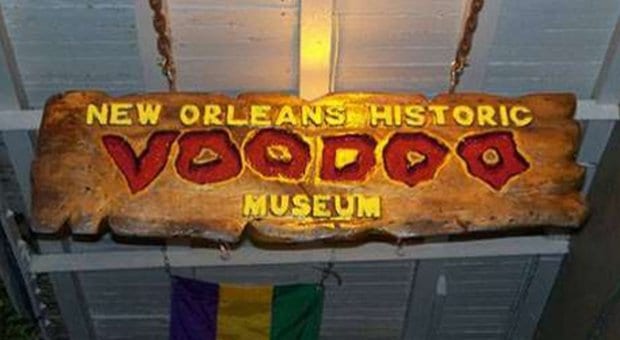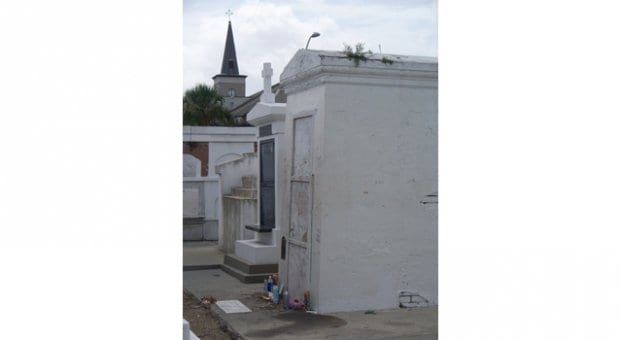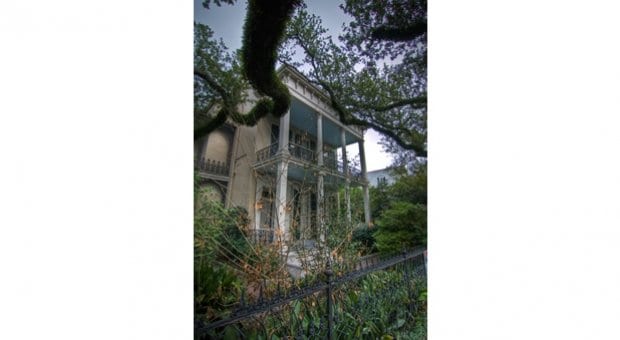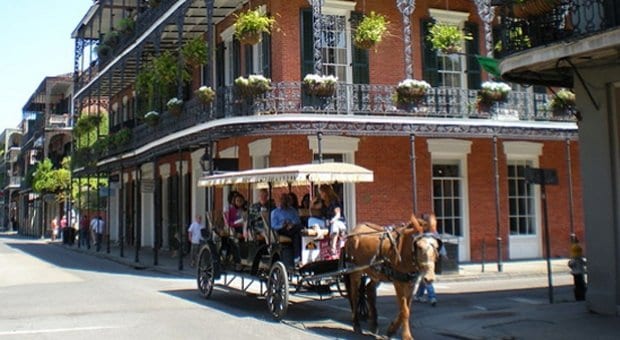
New Orleans’ voodoo underbelly is a major tourist draw, and fakes abound, determined to separate those tourists from their cash. The New Orleans Historic Voodoo Museum isn’t afraid to indulge the imagination or play up its creep factor without straying too far from the religion’s true history. Credit: voodoomuseum.com

The tomb of voodoo queen Marie Laveau gets more visitors each year than the grave of Elvis Presley. Credit: Charles Gandolfo

This house at 1239 First St once belonged to Anne Rice. Credit: Rian Castillo
There were no “vampires” in New Orleans until Anne Rice made them up.
This is the first unsolicited but valuable lesson I get in New Orleans folklore, from the grimly half-smiling man behind the counter of Garden District Book Shop. He’s spied me lifting an autographed hardcover edition of the author’s breakout novel Interview with the Vampire from a small, semi-permanent display dedicated to the famous writer.
One of New Orleans’ favourite bookshops, the store stands proudly behind its local authors. Though Rice hasn’t been one of these for years, the immaculate Garden District is filled with sights that have inspired her and countless others. These include Rosegate, the 1857 First St property purchased by Rice in 1989, adapted as the setting for her novel The Mayfair Witches. Just over the road from Garden District Book Shop, Lafayette Cemetery No 1 served as the not-so-final resting place of Rice’s beloved vampire Lestat. But this historic labyrinth of aboveground tombs also served the city of Lafayette, which occupied much of the Garden District until it was annexed by New Orleans in 1852. Every morning, tour groups peer between the monuments in this city of the dead, one of several that each day lure visitors looking to separate fact from folklore in this death-obsessed city.
Most have arrived in the company of guides arranged in the French Quarter, heart of the city’s cultural — and gay — life. How many of those guides will reveal the truth about New Orleans’ devotion to interring, rather than burying, its dead? Magic Tours is one, specializing in tours that unearth the city’s real history. Local journalists and historians passionate about their city take visitors through the Garden District, the French Quarter, St Louis Cemetery #1 and on ghost tours throughout the Quarter after dark.
Tours in this last category are a dime a dozen, and unless you love theatrical stunts so campy most drag queens would tell them to tone it down, many are worth about as much. Tour brokers can help sift through the schlock, though Magic Tours and French Quarter Phantoms rank among the best.
All of them are familiar with the LaLaurie Mansion — and thanks, now, in part, to American Horror Story, so are the rest of us. In the finest tradition of lies television told you, there is no public access to the former house of horrors, where Dalphine LaLaurie tortured and mutilated many of her slaves. Former owner Nicholas Cage was reportedly so disturbed by supernatural goings on that he refused to stay in the house. Still, for those content to stand outside and imagine if there can be anything scarier in there than Cage, it’s an essential creepy stop.
Another is Lafitte’s Blacksmith Shop, purported to be the oldest bar in America. The confirmed local writing den of Tennessee Williams, it could well have once been the oldest gay bar, though the queers have long moved on to Cafe Lafitte in Exile (which does openly claim the title), leaving behind a favourite tourist stop — and allegedly, the ghost of a local pirate in the fireplace.
The Tennessee Williams Literary Festival lures more than 2,500 book and arts lovers to the city each March. Dedicated to all things Williams, it combines readings, writing contests, theatre, art shows and a now infamous “Stellaaaaaaaa”-screaming contest that sees tourists in varying states of sobriety drop to their knees and bellow to balconies in the French Quarter. So proud of its queer-lit heritage is New Orleans that LGBT authors get their own celebration in May. Past guests of the Saints and Sinners Literary Festival have included Christopher Rice, Val McDermid, and Lambda-winning Toronto author Jeffrey Round.
To find the neighbourhood that inspired Williams’s A Streetcar Named Desire, trek just beyond the French Quarter to The Marigny. Frenchmen Street is where the locals go for their authentic jazz and cheap eats, and even though most of the LGBT part is centred in the Quarter, several neighbourhood restaurants and bars thrive here and on nearby Elysian Fields. A few doors up lies a cross between a gay bookstore and your favourite crazy aunt’s attic — minus cats — called Fab on Frenchmen. A ramshackle maze of quality new and secondhand books, music, film, knickknacks and random tat, this museum of queer history is an explosion of quirk and an essential stop on any walk around The Marigny.
Like its prolific ghost lore, New Orleans’ voodoo underbelly is a major tourist draw, and fakes abound, determined to separate those tourists from their cash. Dodging them in the French Quarter narrows the field to two main locations. The New Orleans Historic Voodoo Museum, on Dumaine Street, isn’t afraid to indulge the imagination or play up its creep factor without straying too far from the religion’s true history. Those wanting a closer look at voodoo practices today should trek north to Rampart Street, where priestess Miriam Chamani founded the Voodoo Spiritual Temple. Believers worldwide have flocked to the temple seeking her services, and whether you count yourself among them or not, a visit here is far more likely to yield results than tacking “XXX” on Marie Laveau’s supposed grave!
Rich with history and folklore, the South’s gayest city is an ideal destination for thinking queer snowbirds wanting more than beaches and cocktails from their winter vacation. In keeping with New Orleans’ tradition as a haven of tolerance, nearly all accommodations in the popular parts of town — including a staggering selection of B&Bs — are LGBT-friendly. Just be ready to pay a premium if you’re planning to stay over Mardi Gras or other major festivals.
Of course, The Big Easy also holds a reputation as one of America’s friendliest towns. You may even leave with the invitation of a spare (?) bed for your inevitable return visit!
For the most up-to-date travel information on gay New Orleans, see our City Guide, Listings Guide, Events Guide and Activities Guide.

 Why you can trust Xtra
Why you can trust Xtra